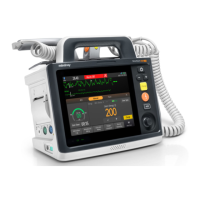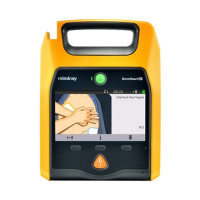14 - 1
14 Monitoring Pulse Oxygen Saturation (SpO
2
)
14.1 SpO
2
Introduction
• The SpO
2
extension cable should be compatible with the SpO
2
connectors. For example, you can
only the Mindray SpO
2
extension cable to the Mindray SpO
2
connectors.
• Measurement accuracy verification: The SpO
2
accuracy has been verified in human experiments by
comparing with arterial blood sample reference measured with a CO-oximeter. Pulse oximeter
measurements are statistically distributed and about two-thirds of the measurements are expected
to come within the specified accuracy range compared to CO-oximeter measurements.
• A functional tester or SpO
2
simulator can be used to determine the pulse rate accuracy.
• A functional tester or SpO
2
simulator cannot be used to assess the SpO
2
accuracy.
14.2 SpO
2
Safety Information
• If the patient has a trend of deoxygenation, analyze the blood samples with a laboratory CO-
oximeter to completely understand the patient's condition.
• Do not use the equipment or SpO
2
sensors during MRI scanning or in an MRI environment. Induced
current could potentially causes burns. The equipment may affect the MRI image, and the MRI
device may affect the accuracy of the SpO
2
measurements.
• Prolonged continuous monitoring may increase the risk of undesirable changes in skin
characteristics, such as irritation, reddening, blistering or burns. Inspect the sensor site every two
hours and move the sensor if the skin quality changes. Change the application site every four hours.
For neonates, or patients with poor peripheral blood circulation or sensitive skin, inspect the sensor
site more frequently.
• Setting alarm limits to extreme values may cause the alarm system to become ineffective. For
example, high oxygen levels may predispose a premature infant to retrolental fibroplasia. Setting
the SpO
2
high alarm limit to 100% is equivalent to switching off the SpO
2
alarm.
• Do not place the equipment or accessories in any position that might cause it to fall on the patient.
• Do not start or operate the equipment unless the setup was verified to be correct.
• Do not loop the patient cabling into a tight coil or wrap around the equipment, as this can damage
the patient cabling.
• If the sensor is too tight because the application site is too large or becomes too large due to edema,
excessive pressure for prolonged periods may result in venous congestion distal from the
application site, leading to interstitial edema and tissue ischemia.
• When patients are undergoing photodynamic therapy they may be sensitive to light sources. Pulse
oximetry may be used only under careful clinical supervision for short time periods to minimize
interference with photodynamic therapy.
• SpO
2
is empirically calibrated in healthy adult volunteers with normal levels of carboxyhemoglobin
(COHb) and methemoglobin (MetHb).
• To protect from electric shock, always remove the sensor and completely disconnect the pulse
oximeter before bathing the patient.
• The pulse oximeter function of the equipment should not be used for apnea monitoring.
• The pulse oximeter function of the equipment should not be used for arrhythmia analysis.

